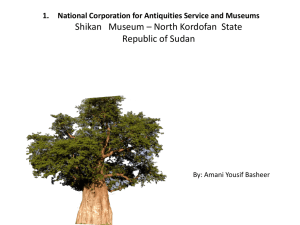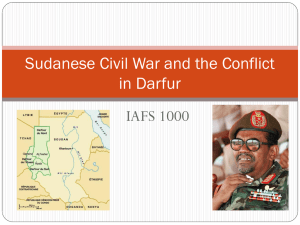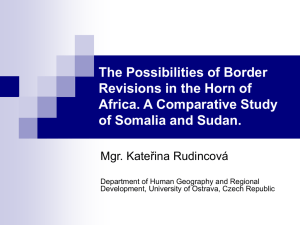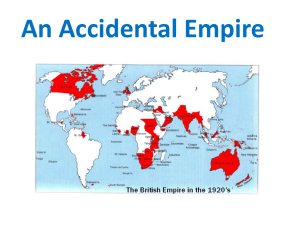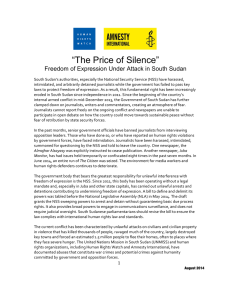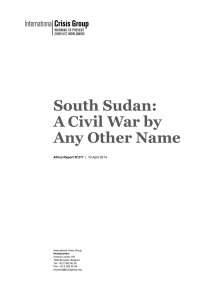Timeline
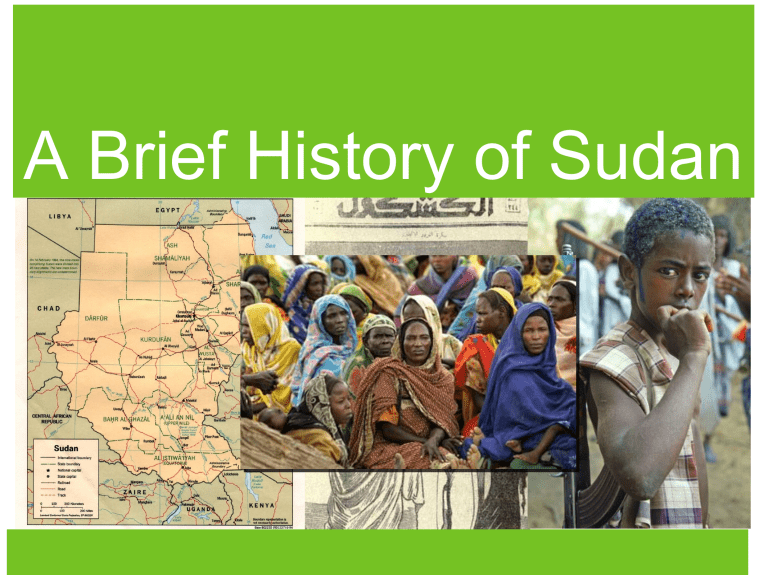
A Brief History of Sudan
Napatan Phase: “The Golden
Age”
• Egyptian political, cultural, and economic influence was prominent in the early history of Sudan. Egypt’s sphere of influence extended into Kush, known for their rich soil, containing vast amounts of iron and gold. The kingdom of Kush was an advanced civilization, being one of the first to have their own written language separate from the traditional Egyptian hieroglyphs of the time, in 300 BC. This control ended when Kush annexed from Egyptian influence in 1000 BC. After gaining independence Kush continued to conquer Egypt in 736 BC, remaining there until 657 BC. Egypt freed itself from Kush in 657 BC, consequently forming two separate and powerful kingdoms,
Alwa and Maqurra.
Pottery from the
Napatan Period
Structure from Napatan Period
Turco-Egyptian Rule (1821-
1885)
• Turcoegyptian forces led by Muhammad ‘Ali conquered Sudan in 1821, instilling turcoegyptian control until 1885. Muhammad ‘Ali, the Ottoman ruler of Egypt, was focused on recruiting Sudanese soldiers and exploiting Sudan’s natural resources.
Under the rule of Muhammad ‘Ali, thousands of Sudanese people were forced to cultivate cotton and were heavily taxed. Thousands of Sudanese people were forced to leave Sudan and go to Egypt, many did not survive the trip. The direct rule of the
Turco-egyptian empire began to be limited as they placed local officials in power, forming indirect rule. The Sudanese people regained further control when the Turkish language was replaced by the native, Arabic. In 1885 a Sudanese group led by
Muhammad Ahamad bin’ Abdallan captured Khartoum, signaling the end of the Turcoegyptian influence in Sudan. Benefits from the Turco-egyptian rule included a trade with other countries, reestablishment of Sudanese leaders, and the introduction of
Arabic culture and language. The slave trade in Sudan was another result of the
Turco-egyptian period, and it continued on after 1885.
4
Slave Trade in Sudan during Turco-Egyptian rule
Dar Fur Region: 1750-1850
• The Fur people are a dominate ethnic group in western Sudan that dates back to the beginning of the seventeenth century. From 1750- 1850 Dar Fur was heavily reliant on trade with Egypt. Consequently, Egyptian customs, culture, and religion were heavily influential on the Fur people. Present day Darfurians practice Islam and are distinctively different from Sudanese people of different regions. This difference has been the main excuse by the Janjaweed and the Arab nomads for their ethnic extermination.
English Colonization: 1898-
1956
• The late eighteenth century was marked by attempt of foreign powers, such as France, to colonize Sudan. In 1898 the Sudanese government was successfully overthrown by
Anglo- Egyptian forces, introducing a new era of British rule and influence. At the time, Great Britain was working in relative tandem with Egypt to control Sudan through direct rule. British colonization ushered in changes for Sudanese infrastructure, restored law, helped the economy flourish, and instituted a modern government.
Egyptian forces were removed from Sudan in 1924, causing Great Britain to employ indirect rule by appointing various local officials under their command. In 1924, the
British government passed the Southern Policy, instilled to scrutinize and restrict the use of Arabic and the religion Islam. This act divided Sudan into two separate regions, the north and the south. Northern Sudan consisted mainly of Muslims and was more affluent, whereas southern Sudan was dominated by various non Muslim religions and remained far behind the north. This spit attributed to the future civil wars in Sudan
Southern Policy: 1924
• In 1924, the British government passed the Southern Policy, instilled to scrutinize and manage the use of Arabic and the spread of Islam. This act divided Sudan into two separate regions, the north and the south, based on religious background. Northern
Sudan consisted mainly of Muslims and was more affluent, whereas southern Sudan was dominated by various non Muslim religions and remained far behind the north.
This spit attributed to the future civil wars in Sudan because of the clashing of cultures, language, and economic situations of each region.
English influence in Sudan
Political Cartoon depicting Great
Britain’s expansive control of Africa
Sudanese Nationalism:
1938- 1958
• Sudan’s fight for independence began in 1938 with the formation of the Graduates’
General Congress (GGC), a group rooted in nationalism. The GGC soon broke off into separate parties, the National Unionist Party (NUP) and the Independence Front (IF), both fighting for control of the Sudanese government. Sudanese independence was finally recognized in 1935 in an agreement between Great Britain and Egypt. The agreement allowed Sudan to be independent of colonization for three years, depending on the status of their progress. During this time Sudanese began to organize a national army and infrastructure. Nationalism formed Sudan into a modern and unified country, however it failed to serve the whole country. The southern regions of Sudan were completely left out of their government, and the government itself was formed to benefit the northern regions of Sudan.
Republic of Sudan: 1958-
1964
• On January 1, 1956 the Republic of Sudan was declared to be under parliamentary rule.
Several religious groups, the Ansar and the Khatmiyya rallied for control of the parliament causing it to be divided, ineffective, and corrupt. The parliament was quickly replaced by a militaristic dictatorship two years later, on November 17, 1958, led by Lieutenant General Ibranhim Abboud. His reign lasted until November 1964, when there was a national push for democracy in Sudan. Attempts to become democratic country failed because of corrupt political leaders and the split between southern and northern Sudan.
Democratic Republic of Sudan:
May 9, 1969
•
The Democratic Republic of Sudan was established on May 9, 1969 when Gaafar
Mohammed Nimeiri took over the previously democratic government. Nimeiri suspended the constitution and the national assembly. On May 25, 1971 Nimeiri abolished all opposing political parties and declared the Democratic Republic of Sudan to be unified under the Sudanese Socialist Union. In the elections of 1971 Nimeiri ran unopposed and was elected president. The elections of 1977 and 1983 carried on in the same fashion, as Nimeiri was continuously reinstated as president. One of the contributions of Nimeiri’s rule to Sudan was the end of the civil wars that had been ongoing since Sudan’s independence in 1956. Inflation, riots, and poor foreign relations are also attributed to Nimeiri’s regime. Nimeiri remained president until 1985, when he was replaced by Mohammed Taha.
Civil Wars (1956-1972)
(1983-current)
• After sixty seven years of British and Egyptian colonization Sudan became independent in 1956. During Sudan’s colonial period the northern part of the country flourished while the southern region remained relatively undeveloped by western influences. The differences between the two regions forged a large division of culture, language, economy, and religion. These dissimilarities fueled the civil wars that have plagued Sudan since its independence in 1956. Another issue that has accredited to cause the civil wars is the division of the Sudan’s People Liberation Army (SPLA) and their constant use of violence to sway the Sudanese government. Many historians blame Sudan’s constant state of civil war to a lack of unity of the states and corrupt government.
Famine of 1989
• In 1989 the Sudan’s People Liberation Army (SPLA) created conflict as the group was successfully defeated the Republic of Sudan, gaining control in the region of
Sudan. That year a drought hit Sudan, causing a major crop failure. The government refused to famine relief to the Southern part of Sudan, fearing that it would aide the SPLA. This left thousands of innocent civilians starving. Various philanthropic organizations attempted to assist the Sudanese, but were expelled from the country entirely. The famine caused inflation, leaving the Sudanese currency virtually worthless. Brought about by drought,swarms of locust, destruction of the civil war. The crop failure devastated the country’s agricultural industry, economy, and overall food supply. Violence erupted throughout Sudan, resulting in the deaths of tens of thousands people throughout the Nile area.
SPLA soldier
Famine Victims
Omar Hasan al- Bashir: June
30, 1989- Present
• After 1969 Sudan was led by various civilians, until June 30, 1989, when Omar Hasan al
Bashir gained control of the government. When in power he established the National
Salvation Revolutionary Command Council (RCC). The RCC was dominated by military influence, with fifteen different militaristic advisors and a insignificant cabinet consisting of civilians. He eliminated the previous constitution of 1985, abused the freedom of press, eliminated unions, and vanquished all alternate political parties other than his own. Bashir issued a state of emergency on April 23, 1990 and disbanded the parliament, giving him and the RCC complete control.
1990-1993 Civil Rule and
Bashir’s Second rise to power
• From 1990 until 1993 Sudan returned to civilian rule until the elections of 1996, were
Bashir again gained political control by a 75% majority in the election. In 2005 Bashir was reinstated as President of Sudan, under popular vote. However, various groups throughout Sudan have protested the election, claiming them to be rigged and unfair.
Rebel groups like the SPLA use violent uprisings to protest Bashir’s government, fueling yet another civil war. On an international level, Bashir is wanted by the
International Criminal Court on charges of crimes against humanity for his part in the atrocities occurring in Darfur.
Genocide in Darfur:
2003- now
• There are currently an estimated 200,000 people that have died as a result of attacks from Arab nomads and the Janjaweed in Darfur, the western region of Sudan. The raids began in 2003 when the Arab nomads, supported by the government, joined with the Janjaweed militia in systematically attempting to regain control of the Darfur region by murdering thousands of Fur citizens. The Janjaweed and the Arab nomads continue to ravage towns, rape women, kidnap children, murder thousands, and cause the displacement of more than two million Darfurians. Millions of refugees have fled to the bordering nation of Chad overcrowding and exhausting their refugee camps. The
SLAM (Sudan Liberation Army) along with the JEM (Justice and Equality Movement) backed the native Fur people, resulting in further conflict between these groups and the rebels. The Sudanese government has refused to allow foreign nations to send relief workers, food, or water to Darfur. In 2004 the United States recognized the mass murders and terrorization of millions of Darfurians as genocide, but has not taken much action to prevent it.
Janjaweed
• The Janjaweed is a malicious Arab militia focused on murdering thousands of
Sudanese people in order to gain control of the Darfur area. The Janjaweed is already held responsible for the murders of over 200,000 innocent people. They are infamous for their atrocities, which include rape, mass executions, and destructions of whole villages and towns. The Janjaweed has been linked to the government of the current president, Omar Hasan al Bashir.
Refugees fleeing
Janjaweed
Works Cited
•
•
•
•
•
• http://www.afroam.org/children/discover/sudan/sudan.gif
"Sudan." Worldmark Encyclopedia of the Nations. 12th ed. Detroit: Thomson Gale, 2007. Reproduced in History
Resource Center. Farmington Hills, MI: Gale. http://galenet.galegroup.com/servlet/History/
"Ancient Civilizations in Africa, 3500 B.C.-500 B.C.." DISCovering World History. Online Edition. Gale, 2003.
Reproduced in History Resource Center. Farmington Hills, MI: Gale. http://galenet.galegroup.com/servlet/History/
"Sudanese Civil War Uses Famine as a Weapon, 1988." DISCovering World History. Online Edition. Gale, 2003.
Reproduced in History Resource Center. Farmington Hills, MI: Gale. http://galenet.galegroup.com/servlet/History/
"Sudan: History and Government." Encyclopedia of Africa South of the Sahara. 4 vols. Charles Scribner's Sons, 1997.
Reproduced in History Resource Center. Farmington Hills, MI: Gale. http://galenet.galegroup.com/servlet/History/
"Dar Fur, History." Encyclopedia of Africa South of the Sahara. 4 vols. Charles Scribner's Sons, 1997. Reproduced in
History Resource Center. Farmington Hills, MI: Gale. http://galenet.galegroup.com/servlet/History/

